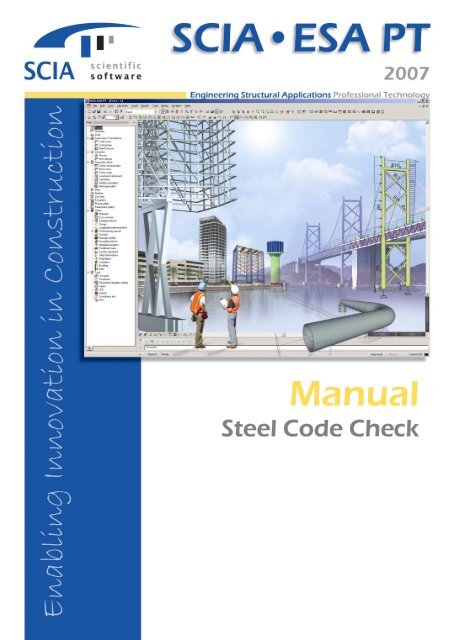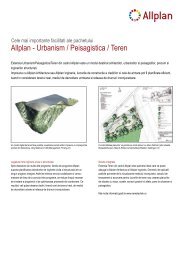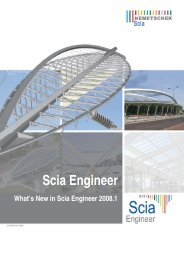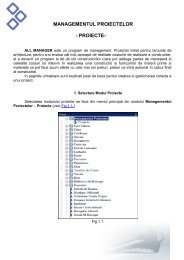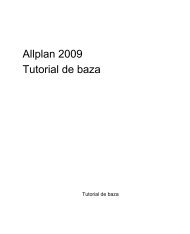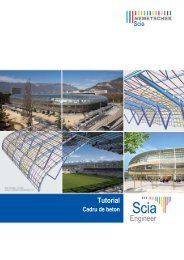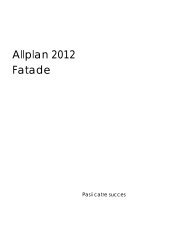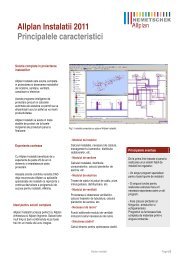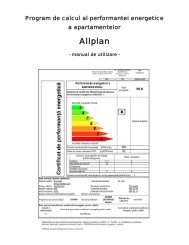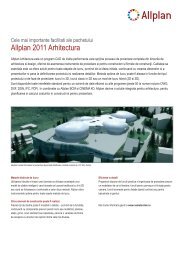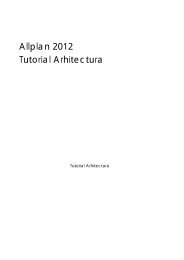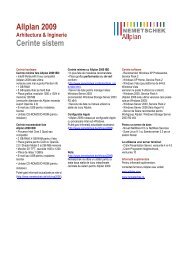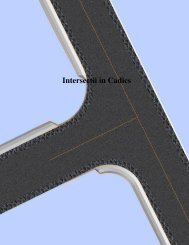Manual Steel Code Check
Manual Steel Code Check
Manual Steel Code Check
You also want an ePaper? Increase the reach of your titles
YUMPU automatically turns print PDFs into web optimized ePapers that Google loves.
<strong>Manual</strong><strong>Steel</strong> <strong>Code</strong> <strong>Check</strong>
<strong>Steel</strong> <strong>Code</strong> <strong>Check</strong>
Table Of ContentsSTEEL CODE CHECKS............................................................................................. 1Welcome................................................................................................................................................................. 1Introduction to code checks.................................................................................................................................. 2PARAMETERS AND SETTINGS FOR CODE CHECKS........................................... 3Basic parameters ................................................................................................................................................... 3<strong>Code</strong> independent basic parameters..................................................................................................................... 3Basic parameters for EC3 .................................................................................................................................... 4Basic parameters for NEN 6770-6771................................................................................................................. 4Basic parameters for CSN 73 1401 ..................................................................................................................... 4Basic parameters for DIN 18800 ......................................................................................................................... 4Basic parameters for ÖNORM B 4300................................................................................................................ 5Basic parameters for BS5950 .............................................................................................................................. 5Basic parameters for CM66................................................................................................................................. 6Basic parameters for GBJ 17-88.......................................................................................................................... 6Basic parameters for BSK99 ............................................................................................................................... 6Basic parameters for SIA263............................................................................................................................... 6Buckling parameters............................................................................................................................................. 6Default buckling parameters................................................................................................................................ 6Buckling parameters for a particular beam.......................................................................................................... 7Principle of input of buckling parameters ......................................................................................................... 10Buckling parameters for EC3 ............................................................................................................................ 11Buckling parameters for NEN 6770-6771......................................................................................................... 12Buckling parameters for CSN 73 1401.............................................................................................................. 12Buckling parameters for DIN 18800 ................................................................................................................. 12Buckling parameters for ÖNorm B 4300........................................................................................................... 13Buckling parameters for CM 66 ........................................................................................................................ 13Buckling parameters for SIA263....................................................................................................................... 13Deflection parameters......................................................................................................................................... 14Permissible relative deformation ....................................................................................................................... 14Fire resistance parameters ................................................................................................................................. 14General fire resistance parameters for EC3 ....................................................................................................... 14General fire resistance parameters for NEN 6072 ............................................................................................. 15General fire resistance parameters for SIA263.................................................................................................. 16Member related fire resistance parameters ........................................................................................................ 16Insulation parameters......................................................................................................................................... 17Member settings .................................................................................................................................................. 18Member settings ................................................................................................................................................ 18Lateral torsional buckling restraints................................................................................................................. 18Lateral-torsional buckling settings .................................................................................................................... 18Stiffeners .............................................................................................................................................................. 18Stiffener settings................................................................................................................................................ 18iii
<strong>Steel</strong> <strong>Code</strong> <strong>Check</strong>Diaphragms ......................................................................................................................................................... 19Diaphragm definition......................................................................................................................................... 19Diaphragm settings............................................................................................................................................ 20Links..................................................................................................................................................................... 21Link settings ...................................................................................................................................................... 21ADJUSTING THE PARAMETERS FOR CODE CHECKS....................................... 23Adjusting the basic parameters ......................................................................................................................... 23Adjusting the default buckling parameters ...................................................................................................... 23Adjusting the buckling parameters for particular members .......................................................................... 23Adjusting the deflection parameters ................................................................................................................. 23Adjusting the general fire resistance parameters............................................................................................. 24Adjusting the fire resistance parameters for a member .................................................................................. 24Defining a new insulation type ........................................................................................................................... 25Adjusting the member settings........................................................................................................................... 25Adjusting the lateral torsional buckling settings.............................................................................................. 26Adjusting the stiffener settings........................................................................................................................... 26Defining a new diaphragm ................................................................................................................................. 27Adjusting the diaphragm settings...................................................................................................................... 27Adjusting the link settings .................................................................................................................................. 28PERFORMING THE CHECKS ................................................................................. 29Prerequisites of the check................................................................................................................................... 29General principles of checking........................................................................................................................... 29Performing the resistance check ........................................................................................................................ 30Performing the slenderness check ..................................................................................................................... 30Performing the fire resistance check ................................................................................................................. 31Performing the relative deformation check ...................................................................................................... 32Displaying the results in tabular form............................................................................................................... 32<strong>Check</strong>ing of a single beam .................................................................................................................................. 33Optimisation ........................................................................................................................................................ 34Introduction to optimisation .............................................................................................................................. 34Principles of optimisation.................................................................................................................................. 34Optimisation parameters for rolled cross-sections............................................................................................. 34Optimisation parameters for welded and solid cross-sections ........................................................................... 35iv
Table Of ContentsOptimising the members.................................................................................................................................... 35THEORETICAL BACKGROUND............................................................................. 37Theoretical background...................................................................................................................................... 37v
<strong>Steel</strong> <strong>Code</strong> <strong>Check</strong>sWelcomeThank you for choosing SCIA.ESA PT.SCIA1974-2007Version 2007.1sciascia<strong>Steel</strong> <strong>Code</strong> <strong>Check</strong>sciasciaModule <strong>Steel</strong> <strong>Code</strong> <strong>Check</strong> has been designed to facilitate the often-demanding task of design and checking ofsteel frame structures.You can find more about the company and its products on www.scia-online.com.1
<strong>Steel</strong> <strong>Code</strong> <strong>Check</strong>Introduction to code checksThe ESA-Prima Win <strong>Steel</strong> <strong>Code</strong> <strong>Check</strong> module is a powerful program for the design of steel structures. Itconsists of stress and stability verifications of steel members according to a specific national code. It is alsopossible to search interactively for the lightest section, which meets the code requirements for selectedloadings (optimisation).The following structural steel design codes are supported EN 1993-1-8 DIN 18800 ONORM 4300 NEN 6770-6771AISC - ASD: Allowable Stress DesignAISC - LRFD: Load and Resistance Factor DesignCM66BS5950SIA263For more details about the used codes and the theoretical background, we refer to the SCIA.ESA PT <strong>Steel</strong><strong>Code</strong> <strong>Check</strong> Theoretical Background.This manual is written for all codes. The general screen copies are taken from the EC3 <strong>Code</strong> <strong>Check</strong>. Wherethe manipulation or input is different from this general way, a proper description and screen copy are given forthe relevant code.2
Parameters and settings for code checksBasic parameters<strong>Code</strong> independent basic parametersBuckling length ratios ky, kzValues of length ratiosThere are various options for buckling ratios:InputtedCalculatedCalculated only if noinputted valueBigger of inputted andcalculated valueLower of inputted andcalculated valueThe program always uses the input values.The program uses the calculated ky and kz factors and neglectall input values.The program uses the calculated ky and kz factors only if thereare no manually inputted values.The program compares the inputted and calculated value for kyand kz factors and uses the greater value.The program compares the inputted and calculated value for kyand kz factors and uses the lower value.Max. k ratioThe calculated value of k is limited and must not exceed the given value.Max. SlendernessIf the slenderness of the checked member exceeds this value, the program prints a warning in the outputreport.2 nd order buckling ratiosFor 2 nd Order calculation, the buckling data as defined can be used, or the structure is considered as non-swayfor all buckling data.Note: For VARH members (see <strong>Steel</strong> <strong>Code</strong> <strong>Check</strong> Theoretical Background, Calculation ofcritical Euler force for VARH elements), only the first three options (Inputted, calculated, calculatedonly if no inputted value) are considered. In other cases, the critical Euler force is calculated.Default sway typesThese default sway types are used for all members, unless the user changes them in the settings made forparticular members.The sway type (with or without bracing) is used for calculation of buckling length ratios. We refer to <strong>Steel</strong> <strong>Code</strong><strong>Check</strong> Theoretical Background, Calculation of buckling ratios for more information on this subject.Elastic check onlyIf this option is checked, all members are assessed to elastic check only and no shear buckling check isperformed.Note: For EC 3,NEN6770/6771,BS5950, SIA263: check as class 3 section, Wel is used and no shearbuckling is considered.Section check onlyIf this option is checked, only the section check is carried out. No stability check is performed.<strong>Check</strong> boundsThe unity checks are classified into three classes:not-utilisedoptimalnon-satisfyingUnity check is lower than the Lower bound (the diagramemploys purple colour).Unity check is between Upper and Lower bound (the diagramemploys green colour).Unity check is greater than the Upper bound (the diagramemploys red colour).3
<strong>Steel</strong> <strong>Code</strong> <strong>Check</strong>In the <strong>Check</strong> bounds group the user may change the Upper and Lower bound. The default settings for thebounds are 0.25 for Lower, and 1 for Upper.Limit for torsional checkThis parameter introduces a limit for torsional check. This value refers to the unity check, based on thetorsional shear stress only. If this value is exceeded, a composed elastic stress check (normal stress andshear stress check) is automatically performed regardless of the section classification.Basic parameters for EC3Safety factorsgamma M0 partial safety factor for resistance of Class 1, 2 or 3 cross-section (1.1)gamma M1partial safety factor for resistance of Class 4 cross-section (1.1) partialsafety factor for resistance of member to buckling (1.1)gamma M2 partial safety factor for resistance of net section at bolt holes (1.25)ky, kz acc. to FEM.10.2.02.If this option is selected the factors ky and kz are set according to FEM.10.2.02 (The Design of <strong>Steel</strong> StaticPallet Racking) regulations: during the stability check for combined bending and axial load, ky, kz = 1 if theunity check comes as a result of a second-order analysis.Basic parameters for NEN 6770-6771Safety factorsgamma M partial safety factor (1.0)LTB stiffeners only for lkipWhen this option is ON, the LTB (lateral-torsional bucking) stiffeners will only influence the length of lkip. Thevalue of lg is taken from buckling data.m1, m2, mmid in buckling planeWhen this option is selected, the values of moments My;1;s;d, My;2;s;d and My;mid;s;d are considered relativeto the system length for buckling around the yy axis, and the values of moments Mz;1;s;d, Mz;2;s;d andMz;mid;s;d are considered relative to the system length for buckling around the zz axis.If this option is not selected, these values are considered relative to the member length.Basic parameters for CSN 73 1401Safety factorsgamma M0gamma M1gamma M2partial safety factor for resistance of Class 1, 2 or 3 cross-section(1.15)partial safety factor for resistance of Class 4 cross-section (1.15) partialsafety factor for buckling resistance (1.15)partial safety factor for resistance of net section (i.e. without bolt holes)(1.15)Basic parameters for DIN 18800Critical LTB according to ..The critical moment for LTB can be calculated according to DIN 18800 (formula 19), according to EC3 - AnnexF, or according to Roik, Carl and Lindner.This selection is valid for symmetrical I shapes only.4
Parameters and settings for code checksFor more information about the calculation of the critical LTB moment, please refer to <strong>Steel</strong> <strong>Code</strong> <strong>Check</strong>Theoretical Background, DIN 18800.Double bending check with ...For double bending, either checking method 1 (formula 28) or method 2 (formula 29) can be chosen.LTB check for RHS/CHS sectionsThe LTB check can be activated for RHS / CHS sections (Rectangular Hollow Section / Circular HollowSection).Only LTB stability check in 2nd Order calculationWhen this option is selected, there is no buckling check performed. Only LTB check is carried out in thestability check.Elastic check according to T1 article 750With this option is ON, the potential plastification described in the stated article, is used.Basic parameters for ÖNORM B 4300Critical LTB according to ..The critical moment for LTB can be calculated according to DIN 18800 (formula 19), according to EC3 - AnnexF, or according to Roik, Carl and Lindner. This selection is only valid for symmetrical I shapes. For moreinformation about the calculation of the critical LTB moment, we refer to <strong>Steel</strong> <strong>Code</strong> <strong>Check</strong> TheoreticalBackground, DIN 18800.Double bending check with ...For double bending, the check method 1 (formula 28) or method 2 (formula 29) can be activated.LTB check for RHS/CHS sectionsThe LTB check can be activated for RHS / CHS sections (Rectangular Hollow Section / Circular HollowSection).Only LTB stability check in 2nd Order calculationWhen this option is selected, there is no buckling check performed. Only LTB check during the stability checkis carried out.Elastic check according to T1 article 750When this option is ON, the potential plastification described in the mentioned article, will be used.Note: Basic parameters for ÖNORM B 4300 are the same as for DIN 18800.Basic parameters for BS5950Section check based onFor plastic and compact sections, BS5950 Art. 4.8.2. & 4.8.3.2. (b) prescribes a detailed approach todetermine the unity check of axially loaded members with moments. The detailed relationship allows greatereconomy for plastic and compact section. In this expression, we use a reduced moment capacity Mr about themajor and the minor axis respectively. Those values are determined by means of EC3 Art.5.4.9. For semicompactand slender section, the simplified approach is applied following Art. 4.8.2.and Art. 4.8.3.2. (a). It ispossible to choose the approach used to perform the control. In the case of a class3 or 4 section, even if theuser has selected the EC3 method, an elastic approach following BS interaction will be performed.Calculation type of m, nm represents the equivalent uniform moment distribution and n represents the equivalent slenderness factor.Those factors are necessary to perform the lateral-torsional buckling check. They are determined as follows:For a beam without loading point between points of lateral restraint, n=1 and m depends on theratio of the end moments at the points of restraint.For a beam loaded between points of lateral restraint, m=1 and n depends on the ratio of the endmoments at the points of restraint and on the ratio of the larger moment to the mid-span freemoment.There are thus two methods for dealing with lateral-torsional buckling namely: 'm approach' i.e. the 'equivalent uniform moment method' with n=15
<strong>Steel</strong> <strong>Code</strong> <strong>Check</strong> 'n approach' i.e. the 'equivalent slenderness method' with m=1In any given situation, only one method will be admissible, taking into account that it is always conservative touse m=n=1. In the Calculation of m, n group, you can let the program to determine both values (m method or nmethod will be automatically determined), choose the 'm method' or select the safe solution m=n=1.Basic parameters for CM66Additif 80<strong>Check</strong> this box in order to perform the check according to Additif 80 for symmetrical I sections and RHSsections. Other sections will be checked according the elastic rules from CM66.Fictive slenderness only for k1<strong>Check</strong> this box if you want to take the fictive slenderness into account only for the value of k1x and k1y.If the option is not checked, the fictive slenderness will influence the values of kfx, kfy, k1x and k1y.Basic parameters for GBJ 17-88Activate plastic checkThe plastic check can be activated, if the section fulfils the plastic conditions.Basic parameters for BSK99Critical LTB according to ..The critical moment for LTB can be calculated according to BSK99 or according to EC3 - Annex F. Thisselection is only valid for symmetrical I shapes.For more information about the calculation of the critical LTB moment, we refer to <strong>Steel</strong> <strong>Code</strong> <strong>Check</strong>Theoretical Background, BSK99.Basic parameters for SIA263Safety factorsGamma M1Gamma M2partial safety factor for resistancepartial safety factor for resistance of net sectionBuckling parametersDefault buckling parametersDescriptionThe default buckling parameters are used whenever a new beam is input into your project. By default, the newbeam takes these default parameters. If required, you may later alter these default values and assign aspecific values to the particular beam.zzyzltdef yydef zzkySystem length for buckling around the local zz axis (weak axis). This is usuallythe length between the points braced in the direction of the local yy axis.System length for torsional buckling. This is the length between the restraintsfor torsion. Both EC3, DIN18800, ONORM4300, NEN6770, SIA263, AISC-ASD and AISC-LRFD take account of torsional buckling.System length for lateral-torsional buckling. This is usually the length betweenthe points braced in yy direction (= length between the lateral restraints).System length for deformation around the local yy axis (strong axis).System length for deformation around the local zz axis (weak axis).The program uses either the inputted or calculated values.6
Parameters and settings for code checkskzInfluenceof loadpositionAlternatively, the buckling length can be input directly.For a theoretical explanation about the calculation of buckling ratios ky and kz,see <strong>Steel</strong> <strong>Code</strong> <strong>Check</strong> Theoretical Background, Calculation of buckling ratios.This field is relevant for lateral-torsional buckling check. It provides forconsideration of destabilising loads in moment factors for LTB (See <strong>Steel</strong> <strong>Code</strong><strong>Check</strong> Theoretical Background, Calculation of moment factors for LTB).Destabilising loads are loads that act above the level of the beam’s shearcentre and are free to move sideways with the beam as it buckles (andproduce a disturbing effect)ProcedureThe procedure is described in chapter Adjusting the default buckling parameters. For your convenience, it isrepeated here as well.The procedure for adjustment of default buckling parameters1. Open service <strong>Steel</strong>:a. either using tree menu function <strong>Steel</strong>,b. or using menu function Tree > <strong>Steel</strong>.2. Select function Setup and open it.3. In the dialogue that appears on the screen, select tab Setup of buckling.4. Type required values and select appropriate options.5. Confirm with [OK].Note: For the relation between default parameters and parameters defined for a particularmember read also chapter Principle of input of buckling parameters .Buckling parameters for a particular beamDescriptionWhen a new beam is defined (i.e. inserted into your model of the analysed structure), it reads the defaultbuckling parameters adjusted through function Setup in service <strong>Steel</strong>.In practice however, it may be necessary to adjust the parameters differently for certain beams. This can bedone in the adjustment dialogue for a particular member.In addition, this adjustment offers some additional options next to those available in the setup of defaultparameters.Buckling and relative lengths dialogueThe Buckling and relative lengths dialogue is divided into two parts:Base settingsinput for the whole member – base settings,input for individual intervals of the member – buckling data.NameNumber of partsBuckling systemsrelation: zzBuckling systemsrelation: yzBuckling systemsrelation: ltIdentifies the buckling length system(informative) Show the number of intervals of the system.System length for buckling around the local zz axis (weak axis).This is usually the length between the points braced in thedirection of the local yy axis. Alternatively, it is possible to define aseparate zz system.System length for torsional buckling. This is the length betweenthe restraints for torsion. This system may be defined separately,or it may be said that it is identical with yy or zz system.System length for lateral-torsional buckling. This is usually thelength between the points braced in yy direction (= lengthbetween the lateral restraints). Alternatively, it is possible to define7
<strong>Steel</strong> <strong>Code</strong> <strong>Check</strong>Relative deformationsystems relation:def z;def yky factor;kz factorsway yy;sway zz;X diagonalsa separate lt system or make it identical with zz system.System length for deformation. The same rules as for Bucklingsystems relation apply here.The program uses either the inputted or calculated values.Alternatively, the buckling length can be input directly.For a theoretical explanation about the calculation of bucklingratios ky and kz, see <strong>Steel</strong> <strong>Code</strong> <strong>Check</strong> Theoretical Background,Calculation of buckling ratios.The sway type is used to determine the relevant buckling factor k.If the box is checked, the member is sway in this direction.It is possible to say directly YES or NO, or to say that the values isto be taken from the default parameters.ExampleSway y-y is set to YES: the member is sway in the planeperpendicular to the local YY axis of the member (the local ZZplane) - Sway for buckling around the local YY axis.If the X diagonal check box is checked, the buckling factor iscalculated according to DIN18800 Teil 2, Table15 (see <strong>Steel</strong> <strong>Code</strong><strong>Check</strong> Theoretical Background, Calculation of buckling ratio) oncondition that member satisfies the specifications given in thechapter.Influence of loadpositioneo d,y;eo d,zBuckling systemNote: If a 2 nd -order calculation is performed, the bucklingfactors are calculated in the non-sway mode or in the definedmode, depending on the settings in the default data.This field is relevant for lateral-torsional buckling check. Itprovides for consideration of destabilising loads in moment factorsfor LTB (See <strong>Steel</strong> <strong>Code</strong> <strong>Check</strong> Theoretical Background,Calculation of moment factors for LTB).Destabilising loads are loads that act above the level of thebeam’s shear centre and are free to move sideways with thebeam as it buckles (and produce a disturbing effect)The following code-based options are available:bow imperfection according to code – elastic (the bowimperfection is calculated according to the codespecifications),bow imperfection according to code – plastic (the bowimperfection is calculated according to the codespecifications),bow imperfection according to code - elastic - only ifrequired (the bow imperfection is calculated according tothe code specifications, if required by the normal forcecondition),bow imperfection according to code - plastic - only ifrequired (the bow imperfection is calculated according tothe code specifications, if required by the normal forcecondition),no bow imperfection.The following code-based options are available:standard method,crossing diagonals (to DIN),leg with symmetrical bracing,8
Parameters and settings for code checksleg with intermediate transverse support,leg with staggered bracing,single bracing with SBS,cross bracing,K bracing,horizontal bracing,discontinuous cross bracing with horizontal member.The individual options are explained in the theoretical backgroundfor <strong>Steel</strong> <strong>Code</strong> <strong>Check</strong>. See the chapters: (i) Calculation of bucklingratio > calculation of buckling ratio - general formula; (ii)Calculation of buckling ratio > calculation of buckling ratio forcrossing diagonals; (iii) Calculation of buckling ratio > calculationof buckling ratio for lattice tower members.Buckling dataDepending on the adjustments made in Base settings (see above), some of the parameters for individualintervals of the buckling length system may be specified in the second part of the dialogue.Some of the parameters contained in this dialogue are code-dependent and appear only for the appropriatenational technical code.Note: For the relation between default parameters and parameters defined for a particularmember read also chapter Principle of input of buckling parameters .ProcedureThe procedure is described in chapter Adjusting the buckling parameters for particular members. For yourconvenience, it is repeated here.The procedure for adjustment of buckling parameters for a particular member1. In the graphical window, select the beam (or beams) whose buckling settings should be modified.9
<strong>Steel</strong> <strong>Code</strong> <strong>Check</strong>2. The beam properties are displayed in the Property window.3. In the table cell System lengths use the combo box to select the required System lengthdefinition and go to the last step of the procedure.4. If the required System length definition has not been defined yet, use the button at the right handside of the cell to create a new System length definition.5. Press button Edit buckling to open the editing dialogue.6. Adjust required parameters.7. Confirm with [OK].8. Clear the selection.Principle of input of buckling parametersSCIA.ESA PT uses for some functions a hierarchical order: application – function / system – a single part.The same principle is used for setting of buckling parameters.The whole applicationThe parameters may be set for the whole application. The parameters are valid for the whole structure ifnothing else is set otherwise.The systemIf necessary, the global settings may be altered for a particular member. The member may consist of several"buckling" intervals. These intervals together form a "buckling system" and such a system may be tuned bymeans of explicitly defined parameters.The partAs stated above, the "buckling system" of a beam may consist of several intervals. And different parametersmay be assigned to each of the intervals.Practical application of the Hierarchical Principle in ESAThe global buckling settings valid for the whole application can be set via function <strong>Steel</strong> > Setup > Setup ofbuckling.The parameters of the "buckling system" of a particular beam and also the parameters for individual intervalscan be adjusted in the Bucking data dialogue (see below).10
Parameters and settings for code checksLet’s have a look at Sway settings for both yy and zz direction. The Sway parameter can be adjusted twice inthe Buckling data dialogue. One setting can be made for the whole "buckling system" of the selected beamor beams (the setting at the right-hand side of the dialogue). The other setting can be made in the table at thebottom part of the dialogue and is valid for a particular buckling interval.System value Interval value Calculation valuethe value set in"buckling system"settings(the right-hand sideof the dialogue)Sway yy =SettingsSway yy =SettingsSway yy =Settingsthe value set in"buckling interval"settings(the bottom part ofthe dialogue)Sway yy =SettingsSway yy = YesSway yy = NoSway zz = Yes Sway zz =Settingsthe value used for calculationsThe global value adjusted in <strong>Steel</strong> > Setup >Setup of buckling will be used.System value accepts the global setting. Intervalvalue accepts the system setting.Sway yy = YES will be used.System value accepts the global setting.Interval value overwrites the system setting.Sway yy = NO will be used.System value accepts the global setting.Interval value overwrites the system setting.Sway zz = YES will be used.System value overwrites the global setting.Interval value accepts the system setting.Sway zz = Yes Sway zz = Yes Sway zz = YES will be used.System value overwrites the global setting.Interval value overwrites the system setting.Sway zz = Yes Sway zz = No Sway zz = NO will be used.System value overwrites the global setting.Interval value overwrites the system setting.Buckling parameters for EC3Warping checkIf this option is ON, a warping check is performed on the member. The end conditions for warping (free, fixed)can be set separately for both ends of member. The implementation of the warping check is described in <strong>Steel</strong><strong>Code</strong> <strong>Check</strong> Theoretical Background, Warping check.k factor for lateral-torsional bucklingkkwRefers to rotational end-restraint ‘in plan’ (around the local zz axis). For endconditionsgiven greater restrained to rotation in plan, values of k < 1.0 can beused. The value can vary from 0.5 for full fixity, to 1.0 for no fixity, with 0.7 forone end fixed and one end free.Refers to end warping (EC3, Annex F).Unless special provision for warping11
<strong>Steel</strong> <strong>Code</strong> <strong>Check</strong>fixity is made, kw should be taken as 1.0.The presence of endplates willinfluence this value.Note: The lateral-torsional buckling check uses the formulas for Mcr (the elastic critical moment)as defined in EC3-Annex F. When the cross section type is not supported by this Annex F (e.g. Usections) , a general formula is used, where it is supposed that the applied loadings are passingthrough the shear centre of the section. More info is given in the 'Theoretical Background'.Buckling parameters for NEN 6770-6771Fy; tot; s; d and Fz; tot; s; dFor code NEN 6770 / 6771, value Fy;tot;s;d and Fz;tot;s;d can be modified with the so-called "aanpendelendebelasting" in ly and lz section as follows:The factor A and the value B can be introduced.k factor for lateral-torsional bucklingF; tot; s; d = Nc; s; d + Nc; s; d × A + BkLTBk1kgThe lateral torsional buckling (LTB) length is defined by lLTB = kLTB * LLTBThe length lkip is given by lkip = lLTB * k1The length lg is given by lg = lLTB * kgWarping checkIf this option is ON, a warping check is performed on the member. The end conditions for warping (free, fixed)can be set separately for both ends of member. The implementation of the warping check is described in <strong>Steel</strong><strong>Code</strong> <strong>Check</strong> Theoretical Background, Warping check.Buckling parameters for CSN 73 1401Other lateral-torsional buckling parameterskappa M If this parameter is NOT equal to zero and, at the same time, both Kappa 1and Kappa 2 ARE equal to zero, the calculation of slenderness for lateraltorsionalbuckling is carried out in accordance with Appendix H6 of the code.Kappa 1Kappa 2lambda lt(lam_lt)If this parameter is NOT equal to zero and simultaneously Kappa 2 is NOTequal to zero, the calculation of slenderness for lateral-torsional buckling iscarried out in accordance with Appendix H2 of the code.If this parameter is NOT equal to zero and simultaneously Kappa 1 is NOTequal to zero, the calculation of slenderness for lateral-torsional buckling iscarried out in accordance with Appendix H2 of the code.Direct input of slenderness for lateral-torsional buckling. If a non-zero value isgiven, the value is always considered as the slenderness for lateral-torsionalbuckling.ATTENTION: This parameter must ALWAYS be input for U-profiles (seebelow)!Important note: Lateral-torsional buckling check for U-profiles gives a completely misleadingresult if parameter lambda lt is not defined.Buckling parameters for DIN 18800Warping checkIf this option is ON, a warping check is performed on the member. The end conditions for warping (free, fixed)can be set separately for both ends of member. The implementation of the warping check is described in <strong>Steel</strong><strong>Code</strong> <strong>Check</strong> Theoretical Background, Warping check.ßzThis parameter refers to rotational end-restraint ‘in plan’ (around the local zzaxis). For end-conditions given greater restrained to rotation in plan, values ofß < 1.0 can be used. The value can vary from 0.5 for full fixity, to 1.0 for no12
Parameters and settings for code checksß0fixity, with 0.7 for one end fixed and one end free.This refers to end warping. Unless special provision for warping fixity is made,ß0 should be taken equal to 1.0.The presence of endplates will influence thisvalue.Buckling parameters for ÖNorm B 4300Warping checkIf this option is ON, a warping check is performed on the member. The end conditions for warping (free, fixed)can be set separately for both ends of member. The implementation of the warping check is described in <strong>Steel</strong><strong>Code</strong> <strong>Check</strong> Theoretical Background, Warping check.ßzß0This parameter refers to rotational end-restraint ‘in plan’ (around the local zzaxis). For end-conditions given greater restrained to rotation in plan, values ofß < 1.0 can be used. The value can vary from 0.5 for full fixity, to 1.0 for nofixity, with 0.7 for one end fixed and one end free.This refers to end warping. Unless special provision for warping fixity is made,ß0 should be taken equal to 1.0.The presence of endplates will influence thisvalue.Note: Basic parameters for ÖNORM B 4300 are the same as for DIN 18800.Buckling parameters for CM 66k factor for lateral-torsional bucklingkLTBThe lateral-torsional buckling (LTB) length is defined by lLTB = kLTB * LLTB.This is the equivalent of length l0 in CM66: the length between supports forLTB.k1 The length l is given by l = lLTB * k.l is defined in CM66 as the buckling length of the compressed part that ispresumed to be isolated from the element.Buckling parameters for SIA263Warping checkIf this option is ON, a warping check is performed on the member. The end conditions for warping (free, fixed)can be set separately for both ends of member. The implementation of the warping check is described in <strong>Steel</strong><strong>Code</strong> <strong>Check</strong> Theoretical Background, Warping check.k factor for lateral-torsional bucklingkkwRefers to rotational end-restraint ‘in plan’ (around the local zz axis). For endconditionsgiven greater restrained to rotation in plan, values of k < 1.0 can beused. The value can vary from 0.5 for full fixity, to 1.0 for no fixity, with 0.7 forone end fixed and one end free.Refers to end warping (EC3, Annex F).Unless special provision for warpingfixity is made, kw should be taken as 1.0.The presence of endplates willinfluence this value.Note: The lateral-torsional buckling check uses the formulas for Mcr (the elastic critical moment)as defined in SIA263. When the cross section type is not supported in SIA263, the formulas fromEC3-Annex F, or a general formula (e.g. U sections) used. In this latest formula , it is supposed thatthe applied loadings are passing through the shear centre of the section. More info is given in the'Theoretical Background'13
<strong>Steel</strong> <strong>Code</strong> <strong>Check</strong>Deflection parametersPermissible relative deformationThe maximum permissible relative deformation may be adjusted separately for individual beam types:general beam,beam,column,gable column,secondary column,rafter,purlin,roof bracing,wall bracing,girt,truss chord,truss diagonal,plate rib.Fire resistance parametersGeneral fire resistance parameters for EC3The general parameters define applied procedures and specify code-related parameters used throughout thechecking of a beam concerning its fire resistance:temperature curvecoefficient of heattransfer by convectionemissivity related tofire compartmentemissivity related tosurface materialcorrection factor forbeam exposed on 3sidescorrection factor forcolumns and beamsAvailable temperature curves are:ISO 834 curveexternal fire curvehydrocarbon curvesmouldering fire.Default value is 25 W/m²K- ENV 1991-2-2 Art. 4.1.(8)Default value is 0.8.– ENV 1991-2-2 Art. 4.2.1.(3)Default value is 0.625.- ENV 1991-2-2 Art. 4.2.1.(3)Adaptation factor for non-uniform temperature distributionacross a cross section exposed on three sides. Default value =0.70.K 1 - ENV 1993-1-2:, 4.2.3.3. (8).This value is a correction factor that allows for a number ofeffects, including the difference in the strain at failure. Thevalue is empirical.Default value = 1.2ENV 1993-1-2, 4.2.3.2. (1).ENV 1993-1-2, 4.2.3.3. (5).factor for net heat flux Default value is 1.0.14
Parameters and settings for code checks(convection part)factor for net heat flux(radiation part)configuration factor forradiation heat fluxanalysis typeiterative processmodel fire engineeringsafety factor for firesituation- ENV 1991-2-2 Art. 4.2.1.(2)Default value is 1.0.- ENV 1991-2-2 Art. 4.2.1.(2)Default value is 1.0.- ENV 1991-2-2 Art. 4.1.(4)The fire resistance check can be performed in three domains:strength domain,temperature domain,time domain.In the resistance domain, the resistance is checked after theimposed time. In the temperature / time domain, the materialtemperature (after the imposed time) is checked in relation tothe critical material temperature.The critical material temperature is calculated using theanalytical formulas of the code, or by an iterative process.The Fire Resistance checking is carried out by means ofchecks defined in ENV 1993-1-2:1995 or by means of checksas they are defined in 'ECCS N° 111 - Model <strong>Code</strong> on FireEngineering'.The partial safety factor for fire situation, default value is 1.0- ENV 1993-1-2 Art. 2.3.(1), (2), (3)General fire resistance parameters for NEN 6072The general parameters define applied procedures and specify code-related parameters used throughout thechecking of a beam concerning its fire resistance:temperature curvecorrection factor forbeam exposed on3 sidescorrection factor forcolumns and beamsanalysis typeAvailable temperature curves are:ISO 834 curve,external fire curve,hydrocarbon curve,smouldering fire.Adaptation factor for non-uniform temperature distributionacross a cross section exposed on three sides.Default value = 0.70.This value is a correction factor that allows for a number ofeffects, including the difference in the strain at failure.The value is empirical.Default value = 1.2.The fire resistance check can be performed in three domains:strength domain,temperature domain,time domain.In the resistance domain, the resistance is checked after theimposed time.In the temperature or time domain, the material temperature(after the imposed time) is checked in relation to the criticalmaterial temperature.15
<strong>Steel</strong> <strong>Code</strong> <strong>Check</strong>iterative processsafety factor for firesituationThe critical material temperature is calculated using theanalytical formulas of the code, or by an iterative process.The partial safety factor for fire situation.Default value is 1.0.General fire resistance parameters for SIA263The general parameters define applied procedures and specify code-related parameters used throughout thechecking of a beam concerning its fire resistance:temperature curvecoefficient of heattransfer by convectionemissivity related tofire compartmentemissivity related tosurface materialcorrection factor forbeam exposed on 3sidescorrection factor forcolumns and beamsfactor for net heat flux(convection part)factor for net heat flux(radiation part)configuration factor forradiation heat fluxanalysis typeiterative processsafety factor for firesituationAvailable temperature curves are:ISO 834 curveexternal fire curvehydrocarbon curvesmouldering fire.Default value is 25 W/m²KDefault value is 0.8.Default value is 0.625.Adaptation factor for non-uniform temperature distributionacross a cross section exposed on three sides. Default value =0.70.This value is a correction factor that allows for a number ofeffects, including the difference in the strain at failure. Thevalue is empirical.Default value = 1.2See ENV 1993-1-2:1995, 4.2.3.2. (1).Default value is 1.0.Default value is 1.0.Default value is 1.0.The fire resistance check can be performed in three domains:strength domain,temperature domain,time domain.In the resistance domain, the resistance is checked after theimposed time. In the temperature / time domain, the materialtemperature (after the imposed time) is checked in relation tothe critical material temperature.The critical material temperature is calculated using theanalytical formulas of the code, or by an iterative process.The partial safety factor for fire situation, default value is 1.0Member related fire resistance parametersIt is possible to set particular fire resistance parameters to individual members in the structure.time resistanceSpecifies the required fire resistance.16
Parameters and settings for code checksbuckling ratio kybuckling ratio kzfire exposurecovered flangeprotectioninsulationthicknessk2Multiplication factor forcorrectionWhen this ratio is greater than 0.0, the 'normal' definedbuckling ratio ky will be overruled by this value.When this ratio is greater than 0.0, the 'normal' definedbuckling ratio kz will be overruled by this value.The section may exposed to fire on all or only three sides.When section is exposed to fire on 3 sides, the covered flangemust be defined.Defines whether the section is protected or not.Defines the type of insulation used as a protection.Specifies the thickness of the protection.This parameters is the adaptation factor for non-uniformtemperature distribution along the beam.Recommended values :k2 = 0.85 : at supports of a statically indeterminate beam,k2 = 1.00 : for all other cases.ENV 1993-1-2 Art. 4.2.3.3.(9)Insulation parametersIf a particular member in the structure is protected by a kind of insulation, the user may specify the parametersof such insulation.EncasementtypeInsulation typeUnit massThermalconductivitySpecific heatDefault value forthicknessKd,efPossible types are:hollow encasement,contour encasement (see picture below).The insulation may be:board protection,spray protection,intumescent coating.self-explanatoryself-explanatoryself-explanatoryEach particular insulation type may be used in the structure severaltimes. Each time it may be applied with a different thickness. Theparameter here defines the default value of thickness. The concretethickness for each particular application may be adjusted in thedialogue of Member related fire resistance parameters.Effective coefficient of heat transfer for intumescent coating.Encasement type17
<strong>Steel</strong> <strong>Code</strong> <strong>Check</strong>hollow encasementcontour encasementMember settingsMember settingsThe user may define a set of member parameters for each beam in the structure and thus control the type ofchecking.NameSectionclassificationElastic checkonlySection checkonlyFieldDefines the name of member data set.This item allows the user to decide whether the classification of crosssectionshould be performed automatically by the program or whetherthe used himself/herself takes the responsibility of classification.If this option is ON, only the elastic check is carried out.If this option is ON, only the section check is carried out.This group of items provides for the definition of a "field" or intervalwhere the adjusted data are valid.Lateral torsional buckling restraintsLateral-torsional buckling settingsLTB restraints are supports against lateral-torsional buckling (LTB) at the top or bottom flange of the beam.The topside is defined by the positive local z- axis of the section. It means that for a positive My (which causescompression at the topside) the LTB length (and the related moment factors - see <strong>Steel</strong> <strong>Code</strong> <strong>Check</strong>Theoretical Background, Calculation of moment factors for LTB) is calculated by the position of the stiffeners atthe topside. The bottom side is defined by the negative local z-axis of the section. It means that for a negativemoment My (which causes compression at the bottom side) the LTB length (and the related moment factors -see <strong>Steel</strong> <strong>Code</strong> <strong>Check</strong> Theoretical Background, Calculation of moment factors for LTB) is calculated by theposition of the stiffeners at the bottom side. When no LTB stiffeners are defined, the values, introduced in theBuckling data dialog are used.If required, it is possible to define the position of points where lateral-torsional buckling is prevented.NamePosition zPosition xCo-ordinatedefinitionRepeatDelta xDefines the name of restraint.Specifies the position in Z direction, i.e. either the topside or the bottomside.Specifies the position in X (longitudinal) direction.Defines the co-ordinate system in which the position x is inputted.Tells how many times the restraint is repeated.Defines the distance between individual restraints.This item is available only if Repeat is greater than one.StiffenersStiffener settingsWeb stiffeners are used to prevent shear buckling, which can be a design failure mode for high and slender(thin webs) profiles.If required, it is possible to define the position and dimensions of stiffeners.NameDefines the name of the stiffener (set of stiffeners).18
Parameters and settings for code checksMaterialThicknessDecreasePosition xCo-ordinatedefinitionRepeatRegularlyDelta xOn beginOn endSpecifies the material used for the stiffener.Determines the thickness of the stiffener.Specifies the position in X (longitudinal) direction.Defines the co-ordinate system in which the position x is inputted.Tells how many times the restraint is repeated.Tells that stiffeners are positioned regularly with the same distancebetween two adjacent stiffeners.Defines the distance between individual stiffeners.This item is available only if Repeat is greater than one.Specifies whether the first stiffener should be applied.Specifies whether the last stiffener should be applied.DiaphragmsDiaphragm definitionA diaphragm is defined by a set of basic parameters.NameName of the diaphragm.I moment Moment of inertia (i.e. second moment of area) per length.K1 +Factor K1 for positive position.K2 +Factor K2 for positive position.K1 -Factor K1 for negative position.K2 -Factor K2 for negative position.ADimension A: see the Fig. below.BDimension B: see the Fig. below.CDimension C: see the Fig. below.DDimension D: see the Fig. below.Thickness Thickness of the sheet.19
<strong>Steel</strong> <strong>Code</strong> <strong>Check</strong>In addition, other settings must be made in order to apply the diaphragm in a structure model.Diaphragm settingsThe diaphragm is completely defined by means of:basic geometrical parameters,settings determining its position in a model.The settings for the diaphragm are:NameDiaphragm LibkDiaphragmpositionBolt positionBold pitchFrame distanceLengthPosition x1Position x2Co-ordinatedefinitionOriginName of diaphragm settings set.Type of defined diaphragm.The value of coefficient k depends on the number of diaphragms:k = 2 for 1 or 2 lateral diaphragms,k = 4 for 3 or more diaphragms.The position of the diaphragm may be either positive or negative.Positive means that the diaphragm is assembled in a way so that thewidth is greater at the top side.Negative means that the diaphragm is assembled in a way so that thewidth is greater at the bottom side.Bolts may be located either at the top or bottom side of the diaphragm.Bolts may be either:in every rib (i.e. "br"),in each second rib (i.e. "2 br").The distance of frames (i.e. the span of transverse bonds).The length of the transverse bond.Value x1 specifies the begin-point of the diaphragm on the beam.Value x1 specifies the end-point of the diaphragm on the beam.Defines the co-ordinate system in which the position x is inputted.Defines the origin from which the position x is measured.Note: This set of parameters is not available for checking to AISC-ASD, Korean Standard andGBJ 17-88.20
Parameters and settings for code checksNote: For more info, see chapter Use of diaphragms in <strong>Steel</strong> <strong>Code</strong> <strong>Check</strong> TheoreticalBackground.LinksLink settingsFor built-up members, parameters defining links connecting individual partial cross-section of the membermust be defined.DivisionDistance frombeginDistance fromendWidth of linksThicknessOn beginOn endSpecifies the number of links per member.Defines the distance of the first link from the starting point of the beam.Defines the distance of the last link from the end point of the beam.Defines the width of the links.Defines the thickness of the links.Tells whether the first link is applied.Tells whether the very last link is applied.Note: This set of parameters is available for checking to EC3, NEN6770/6771, DIN 18800 andCzech standard. For more info, see chapter Battened compression member of the relevant codein <strong>Steel</strong> <strong>Code</strong> <strong>Check</strong> Theoretical Background.21
Adjusting the parameters for code checksAdjusting the basic parametersThe procedure for adjustment of basic parameters1. Open service <strong>Steel</strong>:a. either using tree menu function <strong>Steel</strong>,b. or using menu function Tree > <strong>Steel</strong>.2. Select function Setup and open it.3. In the dialogue that appears on the screen, select tab Setup for check of steel members.4. Type required values and select appropriate options.5. Confirm with [OK].Adjusting the default buckling parametersThe program provides for pre-setting of buckling parameters. These parameters are considered as defaultvalues whenever a new members is being added into the project.The procedure for adjustment of default buckling parameters1. Open service <strong>Steel</strong>:a. either using tree menu function <strong>Steel</strong>,b. or using menu function Tree > <strong>Steel</strong>.2. Select function Setup and open it.3. In the dialogue that appears on the screen, select tab Setup of buckling.4. Type required values and select appropriate options.5. Confirm with [OK].Note: If necessary, the parameters of particular members may be set different from the default.Adjusting the buckling parameters for particularmembersWhen a new member is being defined it takes the current default settings for buckling parameters. Ifnecessary, it is possible to adjust unique parameters for each particular member.The procedure for adjustment of buckling parameters for a particular member1. In the graphical window, select the beam (or beams) whose buckling settings should be modified.2. The beam properties are displayed in the Property window.3. In the table cell System lengths use the combo box to select the required System lengthdefinition and go to the last step of the procedure.4. If the required System length definition has not been defined yet, use the button at the right handside of the cell to create a new System length definition.5. Press button Edit buckling to open the editing dialogue.6. Adjust required parameters.7. Confirm with [OK].8. Clear the selection.Note: See also Buckling parameters related to a particular beam.Adjusting the deflection parametersThe procedure for adjustment of deflection parameters23
<strong>Steel</strong> <strong>Code</strong> <strong>Check</strong>1. Open service <strong>Steel</strong>:a. either using tree menu function <strong>Steel</strong>,b. or using menu function Tree > <strong>Steel</strong>.2. Select function Setup and open it.3. In the dialogue that appears on the screen, select tab Setup of relative deformation.4. Type required values and select appropriate options.5. Confirm with [OK].Adjusting the general fire resistance parametersThe procedure for adjustment of fire resistance parameters1. Open service <strong>Steel</strong>:a. either using tree menu function <strong>Steel</strong>,b. or using menu function Tree > <strong>Steel</strong>.2. Select function Setup and open it.3. In the dialogue that appears on the screen, select tab Setup of fire resistance.4. Type required values and select appropriate options.5. Confirm with [OK].Adjusting the fire resistance parameters for amemberFor each member, the user mat specify concrete parameters related to the fire resistance of the particularmember.The procedure for adjustment of member data1. Open service <strong>Steel</strong>:a. either using tree menu function <strong>Steel</strong>,b. or using menu function Tree > <strong>Steel</strong>.2. Select function Fire resistance and open it.3. Type required values and select appropriate options in.4. Confirm with [OK].5. Select beams to which the adjusted values should be applied.6. Close the function.7. A special mark is attached to the selected beams telling that member data have been defined onthem. The marks (member data) remain selected.8. If required, clear the selection.24
Adjusting the parameters for code checksDefining a new insulation typeThe procedure for definition of a new insulation type1. Open the database manager for Insulations:a. either using tree menu function Library > Insulations,b. or using menu function Libraries > Insulations.2. Click button [New] to create a new insulation type.3. A new insulation type is added into the list of defined insulations.4. Click button [Edit] to edit its properties.5. Input the parameters.6. Confirm with [OK].7. Close the database manager.Note: A new insulation type is defined in the program tool called Database manager. Thedatabase manager can be used not only for the definition of a new insulation type, but also forediting of existing ones, for removal of no more necessary ones, and for other operations related tothe management of insulation database.Adjusting the member settingsThe procedure for adjustment of member data1. Open service <strong>Steel</strong>:a. either using tree menu function <strong>Steel</strong>,b. or using menu function Tree > <strong>Steel</strong>.2. Select function Member data and open it.3. Type required values and select appropriate options in.4. Confirm with [OK].5. Select beams to which the adjusted values should be applied.6. Close the function.7. A special mark is attached to the selected beams telling that member data have been defined onthem. The marks (member data) remain selected.8. If required, clear the selection.25
<strong>Steel</strong> <strong>Code</strong> <strong>Check</strong>Adjusting the lateral torsional buckling settingsThe procedure for definition of lateral torsional restraints1. Open service <strong>Steel</strong>:a. either using tree menu function <strong>Steel</strong>,b. or using menu function Tree > <strong>Steel</strong>.2. Select function LTB Restrain and open it.3. Type required values and select appropriate options in.4. Confirm with [OK].5. Select beams to which the adjusted values should be applied.6. Close the function.7. A special mark is attached to the selected beams telling that LTB restraints have been defined onthem. The marks remain selected.8. If required, clear the selection.Adjusting the stiffener settingsThe procedure for definition of diaphragm settings1. Open service <strong>Steel</strong>:a. either using tree menu function <strong>Steel</strong>,b. or using menu function Tree > <strong>Steel</strong>.2. Select function Stiffeners and open it.3. Type required values and select appropriate options in.4. Confirm with [OK].26
Adjusting the parameters for code checks5. Select beams to which the adjusted values should be applied.6. Close the function.7. The stiffeners are displayed along the beams. The displayed stiffeners remain selected.8. If required, clear the selection.Defining a new diaphragmThe procedure for definition of a new diaphragm1. Open the database manager for Diaphragms:a. either using tree menu function Library > Diaphragms,b. or using menu function Libraries > Diaphragms.2. Click button [New] to create a new diaphragm.3. A new diaphragm is added into the list of defined diaphragms.4. Click button [Edit] to edit its properties.5. Input the parameters.6. Confirm with [OK].7. Close the database manager.Note: A new diaphragm is defined in the program tool called Database manager. The databasemanager can be used not only for the definition of a new diaphragm, but also for editing of existingones, for removal of no more necessary ones, and for other operations related to the managementof diaphragm database.Adjusting the diaphragm settingsThe procedure for definition of diaphragm settings1. Open service <strong>Steel</strong>:a. either using tree menu function <strong>Steel</strong>,b. or using menu function Tree > <strong>Steel</strong>.2. Select function Diaphragms and open it.3. Type required values and select appropriate options in.4. Confirm with [OK].5. Select beams to which the adjusted values should be applied.6. Close the function.7. A special mark is attached to the selected beams telling that diaphragms have been defined onthem. The marks remain selected.27
<strong>Steel</strong> <strong>Code</strong> <strong>Check</strong>8. If required, clear the selection.Adjusting the link settingsThe procedure for definition of diaphragm settings1. Open service <strong>Steel</strong>:a. either using tree menu function <strong>Steel</strong>,b. or using menu function Tree > <strong>Steel</strong>.2. Select function Links and open it.3. Type required values and select appropriate options in.4. Confirm with [OK].5. Select beams to which the adjusted values should be applied.6. Close the function.7. The links are displayed along the beams. The displayed links remain selected.8. If required, clear the selection.Note: This set of parameters is available for checking to EC3, NEN6770/6771, DIN 18800 andCzech standard.28
Performing the checksPrerequisites of the checkBefore the user may get down to the business of checking, a set of specific conditions must be met.1. The model of the analysed structure must be properly defined.2. The boundary conditions and loads reflecting the real conditions of the structure must be specified.3. The model of the analysed structure must be calculated, in other words, the internal forces anddeformations must be known.General principles of checkingThe procedure used for performing the checking is analogous to the procedure for evaluation of results.It can be summarised by the following points:1. Opening of the required service.2. Selection of beams that should be checked.3. Selection of load case or load case combination that should be used.4. Adjusting of display parameters.5. Selection of values to be displayed.6. Displaying of the results of the checking.Service <strong>Check</strong>The required type of check can be selected in the tree menu of service <strong>Steel</strong> > Beams. Once the type of thecheck is selected, the appropriate parameters are listed in the Property window.Parameters common for most of the available check types are:SelectionLoad typeLoad case /combination / classFilterValuesExtremeDrawing setupOther specificparametersThe user may display the results either on all or only selectedbeams.Specifies what "load type" is considered for the display.Available load types are:load cases,load case combinations,result classes.For each of the above specified load type a set of availableitems (load cases, combinations, result classes) is offered.The set of beams where the results are displayed may bespecified by means of a filter.For each of the result groups (unity check, fire resistancecheck, etc.) a set of quantities is offered for display. The usermay select which one is really shown.The numerical values may be displayed in specified extremepoints.It is possible to adjust the style of the diagrams.Some of the available result groups (unity check, fire resistancecheck, etc.) may have other group-specific parameters.Selection of membersThe result diagrams may be displayed on:all the beams in the structure,selected beams only.Which variant is actually applied can be adjusted in the Property window by means of parameters Selectionand Filter.29
<strong>Steel</strong> <strong>Code</strong> <strong>Check</strong>SelectionAllUserIf this option is selected, the result diagrams are displayed onall beams in the structure.If this option is chosen, the user must make a selection todefine the beams for the display of result diagrams.The selection must be ended (using [Esc] key or pop-up menu function End of command) before it may beapplied.FilterNoWildcardCross-sectionMaterialLayerNo filter is applied.The set of beams for display is defined by a wildcardexpression.E.g. expression "N*" lists all entities whose name starts withletter N. The expression "B??" lists all entities whose namestarts with letter B and is followed by two characters.Diagrams are shown only on entities of selected cross-section.Diagrams are shown only on entities of selected material.Diagrams are shown only on entities inserted into selectedlayer.Displaying the results after re-adjustment of check parametersWhenever the settings in the Property window of service <strong>Check</strong> are changed, the diagrams on the screenusually require regeneration. Because the fully automatic regeneration could be very slow for excessivemodels, it is up to the user to regenerate the drawing when necessary.Any time the user makes a change that affects the display, the program paints the cell Redraw of the Propertywindow in red colour. Until the user presses the button [Redraw], the cell remains highlighted.Performing the resistance checkThe resistance check offers the user to select from the following variants:unity check,section check,stability check.The procedure for performing the check1. Open service <strong>Steel</strong>:2. Select function <strong>Check</strong>.a. either using tree menu function <strong>Steel</strong>,b. or using menu function Tree > <strong>Steel</strong>.3. In the Property window select the values that should be displayed and adjust the other parametersas required.4. The diagrams are displayed on the screen.Note 1: More information about displaying of results can be found in chapter Results >Displaying the internal forces in the Reference manual for SCIA.ESA PT.Note 2: If a detailed checking of a single beam is required, the user may apply the procedure fora separate checking of individual beams described later in this book.Performing the slenderness checkValues for displayWhen performing the slenderness check, the user may evaluate the following values:Ly System length for buckling around y axis30
Performing the checkskylyLam yBuckling ratio (used during code check) for buckling around y axisBuckling length for buckling around y axisly = Ly * kySlenderness around y axisLzkzlzLam zIy : buckling length for buckling around y axisiy : radius of gyration around z axisSystem length for buckling around z axisBuckling ratio (used during code check) for buckling around z axisBuckling length for buckling around z axislz = Lz * kzSlenderness around z axisl LTBIz : buckling length for buckling around z axisiz : radius of gyration around z axisThe lateral-torsional buckling lengthl LTB = kLTB * L LTBSecond order buckling ratioSecond order buckling ratio of the slenderness check can be obtained by means of:The procedurelinear calculation,second order calculation.The procedure for performing the slenderness check1. Open service <strong>Steel</strong>:a. either using tree menu function <strong>Steel</strong>,b. or using menu function Tree > <strong>Steel</strong>.2. Select function Slenderness.3. In the Property window select the values that should be displayed and adjust the other parametersas required.4. The diagrams are displayed on the screen.Note: More information about displaying of results can be found in chapter Results > Displayingthe internal forces in the Reference manual for SCIA.ESA PT.Performing the fire resistance checkThe procedure for performing the fire resistance check1. Open service <strong>Steel</strong>:a. either using tree menu function <strong>Steel</strong>,b. or using menu function Tree > <strong>Steel</strong>.2. Select function <strong>Check</strong> – Fire resistance.3. In the Property window select the values that should be displayed and adjust the other parametersas required.4. The diagrams are displayed on the screen.31
<strong>Steel</strong> <strong>Code</strong> <strong>Check</strong>Note: More information about displaying of results can be found in chapter Results > Displayingthe internal forces in the Reference manual for SCIA.ESA PT.Performing the relative deformation checkSectionsThe user may select the sections where the check is performed.AllEndThe diagram of relative deformation is drawn in all sections along theevaluated beams.The diagram of relative deformation is drawn only in all end-sections of theevaluated beams.The procedure for performing the relative deformation check1. Open service <strong>Steel</strong>:a. either using tree menu function <strong>Steel</strong>,b. or using menu function Tree > <strong>Steel</strong>.2. Select function Relative deformation.3. In the Property window select the values that should be displayed and adjust the other parametersas required.4. The diagrams are displayed on the screen.Note: More information about displaying of results can be found in chapter Results > Displayingthe internal forces in the Reference manual for SCIA.ESA PT.Displaying the results in tabular formPreview of check resultsThe results of any check may be displayed in the form of readable tables in the Preview window.The procedure for the insertion of a table with check results into the Preview window1. Perform the required type of check.2. In the property window, select the required level of output:a. brief,b. normal,c. detailed.3. 3. Call function Print / Preview table:a. using menu function File > Print data > Print / Preview table,b. using function Print data > Print / Preview table on toolbar Project4. 4. The results are displayed in the Preview window.<strong>Check</strong> results in the DocumentThe results of any check may be displayed in the Document in the form of readable tables. Later the documentmay be edited in a way so that the final report looks as required by those who receive it..The procedure for the insertion of a table with check results into the Document1. Perform the required type of check.2. In the property window, select the required level of output:a. brief,b. normal,c. output.3. Call function Table to document:a. using menu function File > Print data > Table to document,32
Performing the checksb. using function Print data > Table to document on toolbar Project4. The results are inserted into the Document.<strong>Check</strong>ing of a single beamWhen performing one of below listed checks, the user may prefer to see the detailed results of the check forone member at a time.This option is available if item Single check is displayed in the Property window after the check function hasbeen activated.The option is available for:unity check,section check,stability check.For information about these checks see chapter Performing the resistance check.Results of checking for a single beamAfter the button under item Single check is pressed a new dialogue window is opened on the screen.The window may look like:Parts of the "single-check" windowreport windowlongitudinal sectioncross-sectioncontrol buttonsThis part of the dialogue displays all the results available forthe selected check.This part may display results in the form of diagram.Here, the cross-section of the checked beam is shown.The control buttons provide access to various information.Control buttonsCloseNextPrevious<strong>Check</strong>It closes the "single-check" dialogue.It displays results of check of next beam in the structure.It displays results of check of previous beam in the structure.It displays in the report window the overall check results.33
<strong>Steel</strong> <strong>Code</strong> <strong>Check</strong>EffectSectionStabilityIt displays in the report window load which the beam is subject to.It displays in the report window results of section check for the selectedbeam.It displays in the report window results of stability check.OptimisationIntroduction to optimisationOnce a structure has been designed and calculated, it is the time to perform checking and usually a kind ofoptimisation of the original design.SCIA.ESA PT contains a powerful tool for this task. The optimisation of applied profiles may be doneautomatically or semi-automatically. The process of optimisation results in what may be called an economicaland good solution.The optimisation process in SCIA.ESA PT is based on assumptions given in the following chapter.Principles of optimisationAn optimisation in general represents a complex task. A full, complete and really "optimal" optimisation wouldusually lead to a long and often recursive process. Therefore, SCIA.ESA PT implements a kind of compromise.One optimisation step takes account of a single cross-section onlyIt is possible to optimise one cross-section at a time. The user selects the cross-section from a list of all crosssectionsapplied in the structure.One optimisation step considers only "selected" membersIt is possible to limit the optimisation process to only a selected set of members. The user may make aselection to specify which beams of the given cross-section should be considered for the optimisationcalculations.One optimisation step affects the whole structureOnce the optimised cross-section is found, it is applied to ALL members in the structure that are of thespecified cross-section. It is of no importance whether the optimisation calculation was limited to a selectednumber of beams or not. The final effect of the optimisation is that the original cross-section is simply replacedwith the new, i.e. optimised, cross-section.Optimisation parameters for rolled cross-sectionsThe user may control the process of optimisation by means of a set of parameters.<strong>Check</strong> parameterMaximal checkMaximum unity checkThis parameter tells the program what is the maximal allowablevalue for satisfactory checking.This item shows the found maximal check result for theoptimised cross-section.Shape parameters for optimisationSort by heightSort by A (sectionalarea)Sort by Iy (moment ofinertia)The sequence of cross-section is based on the height.The sequence of cross-section is based on the sectional area.The sequence of cross-section is based on the moment ofinertia.Buttons for manual optimisationSet valueThis button enables the user to set manually the required valueof selected dimension (see above).34
Performing the checksNext downNext upThis button finds one-step smaller cross-section according todefined shape parameters (see above).This button finds one-step larger cross-section according todefined shape parameters (see above).Buttons for automatic optimisationSearch for optimalThis button finds automatically the optimal cross-section.Optimisation parameters for welded and solid cross-sectionsThe user may control the process of optimisation by means of a set of parameters.<strong>Check</strong> parameterMaximal checkMaximum unity checkThis parameter tells the program what is the maximal allowablevalue for satisfactory checking.This item shows the found maximal check result for theoptimised cross-section.Shape parameters for optimisationDimensionStepMinimumMaximumThis item determines which of the dimensions of the crosssectionshould be optimised. All other dimensions remainunchanged.This item specifies the step by which the selected dimension idmodified in order to give one-step smaller or larger crosssection.This item specifies the minimal size of the selected dimension.This item specifies the maximal size of the selected dimension.Buttons for manual optimisationSet valueNext downNext upThis button enables the user to set manually the required valueof selected dimension (see above).This button finds one-step smaller cross-section according todefined shape parameters (see above).This button finds one-step larger cross-section according todefined shape parameters (see above).Buttons for automatic optimisationSearch for optimalThis button finds automatically the optimal cross-section.Optimising the membersIt is possible to perform both automatic and manual optimisation. The process for both is identical except thelast but one step. Therefore, only one procedure will be given here in detail. The other one will be explainedbriefly.The procedure for the automatic optimisation of members1. Open service <strong>Steel</strong>.2. Open branch Beams.3. Select function <strong>Check</strong>.4. In the Property window, go to item Filter and set it to Cross-section.5. In the Property window, go to item Cross-section and select the one you want to optimise.35
<strong>Steel</strong> <strong>Code</strong> <strong>Check</strong>6. In the Property window, go to item Selection and set it to User or All, depending on yourrequirements.7. If the item is set to User, make the selection and press button [Esc] to close the selection.8. If the item Selection has been re-adjusted, press button [Redraw] in order to refresh the screenand see the appropriate display.9. In the Property window, go to item Optimisation and press the button there.10. The optimisation dialogue is opened on the screen.11. Adjust the parameters (of rolled or welded profile) as required.12. Press button [Search for optimal]. The program finds the optimal cross-section.13. If you agree, press [OK] to confirm.The procedure for the manual optimisation of membersThe procedure is identical except step 12.In manual optimisation, the user must press (repeatedly, if required) buttons [Next down] and [Next Up], inorder to find the optimal cross-section. Alternatively, it is also possible to set the required value directly bymeans of button [Set value].Note: The project must be calculated beforehand.36
Theoretical backgroundTheoretical backgroundThe theoretical background is given in a separate volume <strong>Steel</strong> <strong>Check</strong> <strong>Code</strong> Theoretical Background.37


